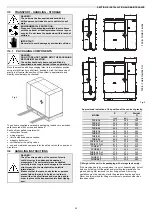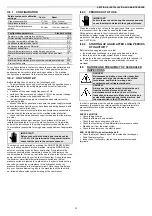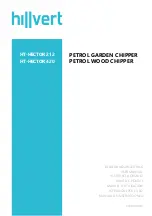
SECTION I: USER
22
I.5 WARNINGS
REGARDING POTENTIALLY TOXIC
SUBSTANCES
DANGER!
Read the following information about the
refrigerants employed carefully.
Adhere scrupulously to the warnings and first aid
procedures indicated below.
I.5.1.1
Identification of the refrigerant fluid type
used
•
Difluoromethane (HFC32) 23% by weight
CAS No.: 000075-10-5
•
Pentafluoroethane (HFC125) 25% by weight
CAS No.: 000354-33-6
•
1, 1, 1, 2 - Tetrafluoroethane (HFC134a) 52% by weight
CAS No.: 000811-97-2
I.5.1.2
Identification of the oil type used
The lubricant used in the unit is polyester oil; please refer to the
indications on the compressor data plate.
DANGER!
For further information regarding the
characteristics of the refrigerant and oil used, refer
to the safety data sheets available from the
refrigerant and oil manufacturers.
I.5.1.3
Main ecological information regarding the
types of refrigerant fluids used
ENVIRONMENTAL PROTECTION!
Read the ecological information and the following
instructions carefully.
•
Persistence and degradation
Decomposes with relative rapidity in the lower atmosphere
(troposphere). Decomposition by-products are highly dispersible and
thus have a very low concentration. They have no influence on
photochemical smog (that is, they are not classified among VOC volatile
organic compounds, according to the guidelines established by the
UNECE agreement). The ozone destruction potential (ODP) of fluids R
32, R 125 and R 134a (contained in the units) is: they do not damage
the ozone. These substance are regulated by the Montreal protocol
(1992 revision).
•
Effects on effluent treatment
Waste products released into the atmosphere do not produce long-term
water contamination.
•
Individual protection/exposure control
Use protective clothing and gloves; protect eyes and face.
•
Professional exposure limits:
R407C
HFC 32
TWA 1000 ppm
HFC 32
TWA 1000 ppm
HFC 134a
TWA 1000 ppm – 4240 mg/m
3
(OES)
•
Handling
DANGER!
Users and maintenance personnel must be
adequately informed about the risks of handling
potentially toxic substances. Failure to observe the
aforesaid indications may cause personal injury or
damage the unit.
Avoid inhalation of high concentrations of vapour. Atmospheric
concentration must be reduced to a minimum and maintained at this
minimum level, well beneath professional exposure limits. Vapour is
heavier than air, and thus hazardous concentrations may form close to
the floor, where overall ventilation may be poor. In this case, ensure
adequate ventilation. Avoid contact with naked flames and hot surfaces,
which could lead to the formation of irritating and toxic products of
decomposition. Do not allow the liquid to come into contact with eyes or
skin.
•
Procedure in case of accidental refrigerant escape
Ensure adequate personal protection (using means of respiratory
protection) during clean-up operations. If the conditions are sufficiently
safe, isolate the source of leak.
If the amount of the spill is limited, let the material evaporate, as long as
adequate ventilation can be ensured. If the spill is considerable,
ventilate the area adequately.
Contain the spilt material with sand, soil, or other suitable non-
absorbent material.
Prevent the liquid from entering drains, sewers, underground facilities or
manholes, because suffocating vapours may form.
I.5.1.4
Main toxicological information on the type
of refrigerant used
•
Inhalation
A high atmospheric concentration can cause anaesthetic effects with
possible loss of consciousness. Prolonged exposure may lead to
irregular heartbeat and cause sudden death.
Higher concentrations may cause asphyxia due to the reduced oxygen
content in the atmosphere.
•
Contact with skin
Splashes of nebulized liquid can produce frostbite. Probably not
hazardous if absorbed through the skin. Repeated or prolonged contact
may remove the skin's natural oils, with consequent dryness, cracking
and dermatitis.
•
Contact with eyes
Splashing liquid may cause frostbite.
•
Ingestion
While highly improbable, may produce frostbite.
I.5.1.5
First aid measures
•
Inhalation
Move the person away from the source of exposure area, keep him/her
warm and let him/her rest. Administer oxygen if necessary. Attempt
artificial respiration if breathing has stopped or shows signs of stopping.
In the case of cardiac arrest carry out heart massage and seek
immediate medical assistance.
•
Contact with skin
In case of contact with skin, wash immediately with lukewarm water.
Thaw tissue using water. Remove contaminated clothing. Clothing may
stick to the skin in case of frostbite. If irritation, swelling or blisters
appear, seek medical assistance.
•
Contact with eyes
Rinse immediately using an eyewash or clean water, keeping eyelids
open, for at least ten minutes.
Seek medical assistance.
•
Ingestion
Do not induce vomiting. If the injured person is conscious, rinse his/her
mouth with water and make him/her drink 200-300 ml of water.
Seek immediate medical assistance.
•
Further medical treatment
Treat symptoms and carry out support therapy as indicated. Do not
administer adrenaline or similar sympathomimetic drugs following
exposure, due to the risk of cardiac arrhythmia.
I.6
INFORMATION ON RESIDUAL RISKS AND
IRREMOVABLE HAZARDS
IMPORTANT!
Pay the utmost attention to the symbols and
instructions located on the appliance.
If any risks remain in spite of the provisions adopted, or if there are any
potential or hidden risks, these are indicated by adhesive labels
attached to the machine in compliance with standard ISO 3864.
Summary of Contents for MICROSYSTEM TCCE 114 H Series
Page 109: ...NOTE 109 NOTE...
Page 110: ...NOTE 110 NOTE...
Page 111: ...Codice Variante Data emissione Modifica H50804 09 11 05 Nuova edizione...
















































